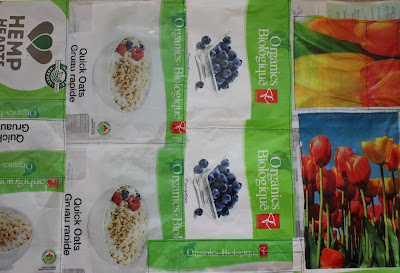I went to Toronto a few weeks ago and went to a workshop with Gunnel Hag at her studio. I really enjoyed the workshop. She showed us how to rust and bleach fabrics. The rusting I had done before but the bleaching was kind of new for me. I'm so used to adding colour to white fabric but in this case we were subtracting colour. We used dark fabrics. When you bleach them you reveal the colours underneath. I used black and dark blue cotton and fabrics to bleach. Under the dark blue there was a pinkish colour and under my black fabric there was a peachy colour. I would like to try using dark green and other darker fabrics too.
This is a dark blue fabric that I folded up into a square and put a circle resist (mason jar lid) on both sides with a clamp and then dipped in the bleach solution. Next time I want to make it an even quicker dip to have more circle showing afterwards.
Here's a close up of one of the circles. You can see the imprint of the lid.
For the fabric below, I sprayed the bleach solution onto my fabric after laying some leaves and grasses on it.
On this black fabric I stamped a thickened bleach solution. I used light pressure so that they wouldn't be perfect squares.
On the fabric below I used a synthetic paint brush and brushed on the bleach solution.
For this dark blue fabric I wound it around a bottle and wound string around it. Then I dipped it in the bleach solution.
I used the same winding string method on this black t-shirt. I used a larger cylinder to do it this time.
Here's the back of the t-shirt. The patterns on the back are neat too.
Here's one of the rusted fabrics I made. It started out as a piece of light blue silk curtain material. The rust turned it grey. Thanks for having a look!


















































